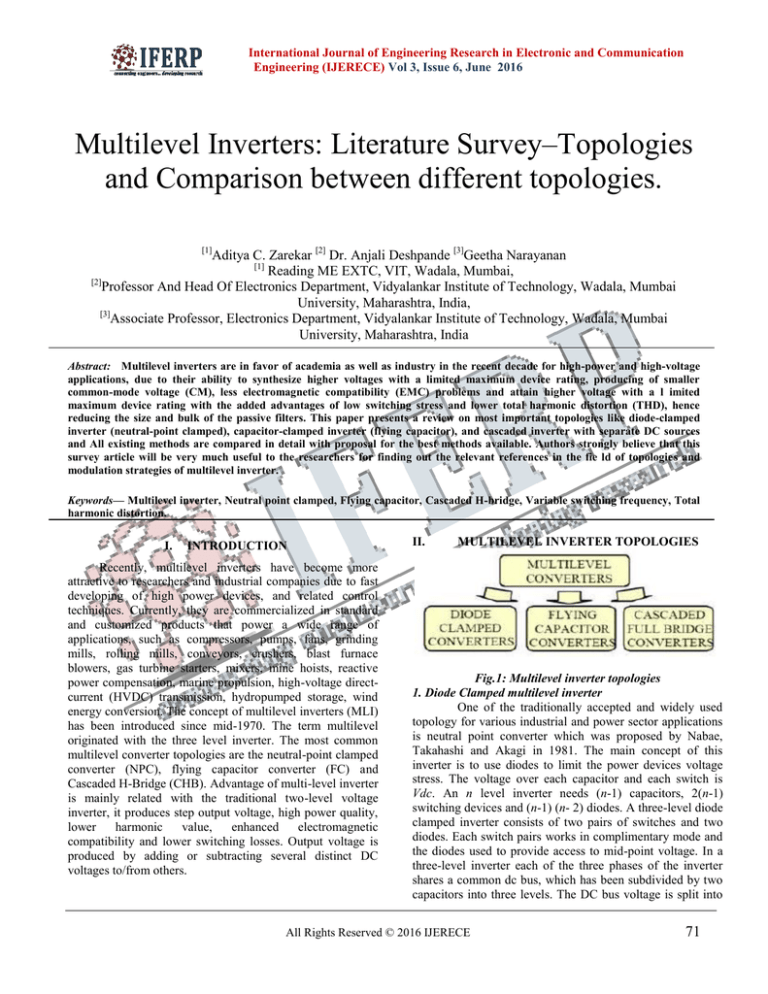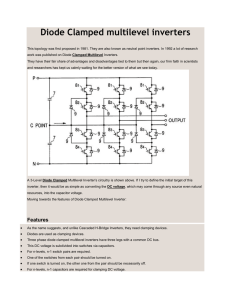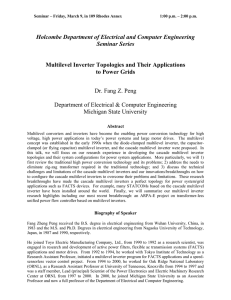
International Journal of Engineering Research in Electronic and Communication
Engineering (IJERECE) Vol 3, Issue 6, June 2016
Multilevel Inverters: Literature Survey–Topologies
and Comparison between different topologies.
[1]
Aditya C. Zarekar [2] Dr. Anjali Deshpande [3]Geetha Narayanan
[1]
Reading ME EXTC, VIT, Wadala, Mumbai,
[2]
Professor And Head Of Electronics Department, Vidyalankar Institute of Technology, Wadala, Mumbai
University, Maharashtra, India,
[3]
Associate Professor, Electronics Department, Vidyalankar Institute of Technology, Wadala, Mumbai
University, Maharashtra, India
Abstract: Multilevel inverters are in favor of academia as well as industry in the recent decade for high-power and high-voltage
applications, due to their ability to synthesize higher voltages with a limited maximum device rating, producing of smaller
common-mode voltage (CM), less electromagnetic compatibility (EMC) problems and attain higher voltage with a l imited
maximum device rating with the added advantages of low switching stress and lower total harmonic distortion (THD), hence
reducing the size and bulk of the passive filters. This paper presents a review on most important topologies like diode-clamped
inverter (neutral-point clamped), capacitor-clamped inverter (flying capacitor), and cascaded inverter with separate DC sources
and All existing methods are compared in detail with proposal for the best methods available. Authors strongly believe that this
survey article will be very much useful to the researchers for finding out the relevant references in the fie ld of topologies and
modulation strategies of multilevel inverter.
Keywords— Multilevel inverter, Neutral point clamped, Flying capacitor, Cascaded H-bridge, Variable switching frequency, Total
harmonic distortion.
I.
INTRODUCTION
Recently, multilevel inverters have become more
attractive to researchers and industrial companies due to fast
developing of high power devices, and related control
techniques. Currently, they are commercialized in standard
and customized products that power a wide range of
applications, such as compressors, pumps, fans, grinding
mills, rolling mills, conveyors, crushers, blast furnace
blowers, gas turbine starters, mixers, mine hoists, reactive
power compensation, marine propulsion, high-voltage directcurrent (HVDC) transmission, hydropumped storage, wind
energy conversion. The concept of multilevel inverters (MLI)
has been introduced since mid-1970. The term multilevel
originated with the three level inverter. The most common
multilevel converter topologies are the neutral-point clamped
converter (NPC), flying capacitor converter (FC) and
Cascaded H-Bridge (CHB). Advantage of multi-level inverter
is mainly related with the traditional two-level voltage
inverter, it produces step output voltage, high power quality,
lower
harmonic
value,
enhanced
electromagnetic
compatibility and lower switching losses. Output voltage is
produced by adding or subtracting several distinct DC
voltages to/from others.
II.
MULTILEVEL INVERTER TOPOLOGIES
Fig.1: Multilevel inverter topologies
1. Diode Clamped multilevel inverter
One of the traditionally accepted and widely used
topology for various industrial and power sector applications
is neutral point converter which was proposed by Nabae,
Takahashi and Akagi in 1981. The main concept of this
inverter is to use diodes to limit the power devices voltage
stress. The voltage over each capacitor and each switch is
Vdc. An n level inverter needs (n-1) capacitors, 2(n-1)
switching devices and (n-1) (n- 2) diodes. A three-level diode
clamped inverter consists of two pairs of switches and two
diodes. Each switch pairs works in complimentary mode and
the diodes used to provide access to mid-point voltage. In a
three-level inverter each of the three phases of the inverter
shares a common dc bus, which has been subdivided by two
capacitors into three levels. The DC bus voltage is split into
All Rights Reserved © 2016 IJERECE
71
International Journal of Engineering Research in Electronic and Communication
Engineering (IJERECE) Vol 3, Issue 6, June 2016
three voltage levels by using two series connections of DC
capacitors, C1 and C2. The voltage stress across each
switching device is limited to Vdc through the clamping
diodes Dc1 and Dc2.
5-level diode clamped multilevel inverter:
A three-phase 5-level diode-clamped inverter is
shown in fig.2. Each of the three phases of the inverter shares
a common dc bus, which has been subdivided by four
capacitors into five levels. The voltage stress across each
switching device is limited to Vdc through the clamping
diodes. In a 5-level diode clamped multilevel: n=5. Number
of capacitors= (n-1) = 4, Number of switches = 2(n-1) = 8,
Number of diodes= (n-1) (n-2) = 12.
The waveform output of five level multilevel
inverter is shown in fig.3. Each phase has four
complementary switch pairs such that turning on one of the
switches of the pair require that the other complementary
switch be turned off. The complementary switch pairs for one
phase leg are (S1, S5), (S2, S6), (S3, S7), (S4, S 8).
Fig.3: Waveform of a five level multilevel inverter
Disadvantages: 1) Real power flow is difficult for a
single inverter because the intermediate dc levels will tend to
overcharge or discharge without precise monitoring and
control. 2) The number of clamping diodes required is
quadratically related to the number of levels, which can be
cumbersome for units with a high number of levels.
III.
FLYING CAPACITOR MULTILEVEL
INVERTER
Meynard and Foch introduced a flying- capacitorbased inverter in 1992. The structure of this inverter is
similar to that of the diode-clamped inverter except that
instead of using clamping diodes, the inverter uses capacitors
in their place. The circuit topology of the flying capacitor
multilevel inverter is shown in Fig.4. The voltage increment
between two adjacent capacitor legs gives the size of the
voltage steps in the output waveform. In addition to the (m-1)
dc link capacitors, the m-level flying-capacitor multilevel
inverter will require (m -1) × (m-2)/2 auxiliary capacitors per
phase. Advantages: 1) Phase redundancies are available for
balancing the voltage levels of the capacitors.
Table 2: The switching states of capacitor clamped
multilevel inverter.
Fig.2: One phase of a diode clamped inverter
Table 1: The switching states of Diode clamped multilevel
inverter.
All Rights Reserved © 2016 IJERECE
72
International Journal of Engineering Research in Electronic and Communication
Engineering (IJERECE) Vol 3, Issue 6, June 2016
Fig.5.shows five level cascaded H-bridge multilevel
inverter. An m level cascaded H-bridge multilevel inverter
needs 2(m- 1) switching devices where m is the number of
the output voltage level. The phase voltage van = vH1 + vH2
+ vH3.
Advantages: 1)Less number of components is
needed for getting same number of voltage level. 2) No need
of extra diodes and capacitors. 3) Because of same structure
it allows the scalable, modularized circuit layout and
packaging.
Fig.4. One phase of a 5-level Flying capacitor multilevel
inverter
2) Real and reactive power flow can be controlled.
3) The large number of capacitors enables the inverter to ride
through short duration outages and deep voltage sags.
Disadvantages: 1) Control is complicated to track the voltage
levels for all of the capacitors. Also, recharging all of the
capacitors to the same voltage level is complex. 2) Switching
utilization and efficiency are poor for real power
transmission. 3) The large numbers of capacitors are both
more expensive and bulky than clamping diodes in multilevel
diode-clamped converters. Packaging is also more difficult in
inverters with a high number of levels.
IV.
CASCADED MULTILEVEL INVERTER
The concept of series H-bridge inverter was first
proposed by R. H. Baker and L. H. Banister in 1975. In order
to overcome the drawbacks of NPC and FC topologies such
as extra clamping diodes and capacitors, Marchesoni.M. have
proposed Cascaded H-Bridge Inverter. The concept of this
inverter is based on connecting H-bridge inverters in series to
get a sinusoidal voltage output. The output voltage is the sum
of the voltage that is generated by each cell. The number of
output voltage levels are 2n+1, where n is the number of
cells. One of the advantages of this type of multilevel inverter
is that it needs less number of components comparative to the
Diode clamped or the flying capacitor, so the price and the
weight of the inverter is less than that of the two former
types.
Fig.5. Seven level cascaded H-bridge multilevel inverter.
All Rights Reserved © 2016 IJERECE
73
International Journal of Engineering Research in Electronic and Communication
Engineering (IJERECE) Vol 3, Issue 6, June 2016
capabilities for applying modulation and soft switching
techniques.
Table 4: Comparison of components required for various
topologies.
Fig.6. Output phase voltage waveform of an 7-level
cascade inverter with 3-separate dc sources.
Disadvantages: Separate DC sources are required for the real
power conversion.
Table 3: The switching states of cascaded H-bridge
multilevel inverter
V.
COMPARISON OF MULTILEVEL
INVERTERS
All three converters have the potential for
application in high voltage applications. The diode clamped
converter is most suitable for the back to back intertie system
operating as a unified power flow controller, other two are
also applicable for the same but they would require more
switching per cycle. All devices are assumed to have same
voltage ratings but not necessarily same current ratings. The
cascaded inverter uses full bridge in each level as compare to
the half bridge versions in other two types. The cascaded
inverter requires the least number of components and has the
potential for utility interface applications because of its
VI.
CONCLUSION
Multilevel inverters are suitable for high voltages
and high current application and also have higher efficiency
because the devices can be switched at a lower frequency.
We hereby conclude that multilevel inverters is a very
promising technology in the power industry. In this paper, the
advantages and disadvantages of multilevel Inverters are
mentioned and a detailed description of different multilevel
inverter topologies is presented. Cascaded multilevel inverter
requires minimum number of components when compared
will other types (it is shown in Table.4). So it produces an
increased stepped output with less number of semiconductor
switches. Authors intentions are to provide the brief idea
about the major topologies of multilevel inverter. Thus after
this study we found that cascaded inverter is the better when
we compare the reliability, modulation scheme and switching
techniques with other topologies.
ACKNOWLEDGMENT
I am very thankful to Dr. Anjali Deshpande and Prof
Geetha Narayanan for their all time support and guiding me
in the proper way to execute my work and for giving me
important inputs regarding the subject.
REFERENCES
[1] Rokan Ali Ahmed,S.Mekhilef and Hew Wooi Ping,
―New Multilevel Inverter Topology With Reduced Number
of Switches‖, Proc. IEEE conf Rec. 978-1-4244-6890-4,
2010, pp.1862-1867.
[2] Panagiotis Panagis, Fotis Stergiopoulos, Pantelis
Marabeas and Stefanos Manias, „Comparison of state of the
All Rights Reserved © 2016 IJERECE
74
International Journal of Engineering Research in Electronic and Communication
Engineering (IJERECE) Vol 3, Issue 6, June 2016
art multilevel inverters‟, in IEEE Conf. Rec.: 978-1-42441668-4/08, 2008, pp.4296-4301.
[3] Alian chen,Chenghuizhang,Haoma and Yan deng ―A
novel multilevel inverter topology with no clamping diodes
and flying capacitors‖ in IEEE.Rec:978-1-4244-1766-7,
2008, pp.3184-3187.
[4] J.Rodriguez, J.S.Lai and F.Z.Peng, „Multilevel inverters:
A survey of topologies, controls and applications‟, IEEE
Trans. Ind. Electron., vol.49, no.4, pp.724-738, 2002.
[5] T. V. V. S Lakshmi , Noby George, S. Umashankar and
D.P. Kothari, ―Cascaded seven level inverter with reduced
number of switches using level shifting PWM technique,‖
IEEE conf. Rec:978-1-4673-6030-2, pp.676-680, 2013.
[6] Javad Ebrahimi, Ebrahim Babaei, Ebrahim Babaei, ―A
new multilevel converter topology with reduced number of
power electronic components‖, IEEE Transactions on
industrial electronics, vol. 59, no. 2, 2012, pp.655-667.
[7] P. Roshankumar, P. P. Rajeevan, K.Mathew, K.
Gopakumar, Jose I. Leon, Leopoldo G. Franquelo, ―A FiveLevel Inverter Topology with Single-DC Supply by
Cascading a Flying Capacitor Inverter and an H-Bridge‖,
IEEE Transactions on Power Electronics, vol. 27, no. 8,
2012, pp.3505-3515.
[8] Jacob James Nedumgatt, D.Vijayakumar, A. Kirubakaran,
S. Umashankar, ― A Multilevel Inverter with Reduced
Number of Switches,‖ IEEE conf. Rec:978 -1-4673-15159,2012.
[9] Zahra Bayat, Ebrahim Babaei, ―A New Cascaded
Multilevel Inverter with Reduced Number of Switches‖, Proc.
IEEE conf Rec, ISBN: 978-1-4673-0113, 2012, PP.416-421.
[10] F.Z. Peng And J.S Lai, ―Multilevel cascade voltage
source inverter with separate DC sources‟, U.S Patent
5642275 June 1997.
[11] B.S Suh, G. Sinha,M. Manjrekar, ―Multilevel power
conversion-An overview of topologies and modulation
strategies‖, in proc. of International conference on
Optimization of Electrical and Electronic Equipments, May
1998, Vol.2, pp.AD11-AD-24
[12] Fang Zhengpeng, Jih Sheng Lai, ―A multilevel voltage
source inverter with separate DC source for static var
generation‖, IEEE Trans. On Industry Applications, Vol.32
No.5, pp1130-1137, 1996.
[13] R. Teodorescu, F. Beaabjerg, J. K. Pedersen, E.
Cengelci, S. Sulistijo, B. Woo, and P. Enjeti, ―Multilevel
converters — A survey,‖ in Proc. European Power
Electronics Conf. (EPE’99) , Lausanne, Switzerland, 1999,
CD-ROM.
[14] F.Z.Peng, J. W. Mckeever, D.J. Adams, ―Cascade
multilevel inverters for utility applications‖, IECON97, 23rd
International Conference on Industrial Electronics, Control
and Instrumentation, vol.2, pp437-442, 1997.
[15] K.A. Corzine, M.W. Wielebski, ―Control of cascaded
multilevel inverters‖, IEEE Trans. on power Electronics,
vol.19, no.3 May 2004, pp.732-738.
[16] T.A. Meynardand H.Foch ―Imbricated cells multilevel
voltage source inverters for high voltage Applications‖,
European power electronics Journal, vol.3 pp.99-106, June
1993.
[17] J.S. Manguelle, A. Rufer,M. Veenstra, ―A generalized
design principle of a uniform step asymmetrical multilevel
converter for high power conversion‖, in proc. of European
Conference on Power Electronics and Applications, Aug
2001
[18] B.P. McGrant and D.G.Holmes, ―Multicarrier PWM
strategies for multilevel inverters‖, IEEE Trans. on Industrial
Electron. Vol.49 Aug.2002, pp. 858-867
[19] A.M. Massoud, S,J. Finney,B.W Williams, ―Control
techniques for multilevel voltage source inverter‖, IEEE 34th
Power Electron. Specialists Conference 2003, vol.1, pp.171176.
[20] D.G Holmes and B.P McGrath, ―Opportunities for
harmonic cancellation with carrier-based PWM for two-level
and multilevel Cascaded Inverters‖, IEEE Trans. on Industry
Applications, vol.37, No 2 pp 574-582, 2001.
[21] A.K. Gupta, A.M. Khambadkone, K.M. Tan, ―A two –
level inverter based SVPWM algorithm for a multilevel
inverter‖, in Proc. Annu. Conf. IEEE Ind.Electron.
Soc.(IECON), Nov.2004, Vol.2,pp1823-1828.
[22] Peftitsis D, Tolstoy G, Antonopoulos A, Rabkowski J,
Lim, Jang-Kwon, Bakowski M, Ängquist L, Nee, H-P."HighPower Modular Multilevel Converters With SiC JFETs".
IEEE Transactions on Power Electronics. 2012;27(1): 28, 36.
[23] Ferreira JA. "The Multilevel Modular DC Converter".
IEEE Transactions on Power Electronics. 2013; 28(10):4460,
4465.
All Rights Reserved © 2016 IJERECE
75
International Journal of Engineering Research in Electronic and Communication
Engineering (IJERECE) Vol 3, Issue 6, June 2016
[24] Khan FH, Tolbert LM. "A Multilevel Modular
Capacitor-Clamped DC–DC Converter". IEEE Transactions
on Industry Applications. 2007; 43(6): 1628, 1638.
[25] Baruschka L, Mertens A. "Comparison of Cascaded HBridge and Modular Multilevel Converters for BESS
application". Energy Conversion Congress and Exposition
(ECCE), 2011 IEEE. 2011: 909, 916.
[26] Ilves K, Antonopoulos A, Norrga S, Nee HP. "A new
modulation method for the modular multilevel converter
allowing fundamental switching frequency". Power
Electronics and ECCE Asia (ICPE & ECCE), 2011 IEEE 8th
International Conference on. 2011: 991, 998.
[27] Chun Gao, Jianguo Jiang, Xingwu Yang, Liang Xie, Kai
Cao. "A novel topology and control strategy of modular
multilevel converter (MMC)". 2011 International Conference
on Electrical and Control Engineering (ICECE). 2011: 967,
971.
[28] Lucheng Hong, Qirong Jiang, Liang Wang, Wei Du. "A
new topology and control strategy for centralized ridethrough
capability of wind farm". IECON 2012 - 38th Annual
Conference on IEEE Industrial Electronics Society. 2012:
3516, 3520.
All Rights Reserved © 2016 IJERECE
76





